Leaves are flattened lateral outgrowths of the stem which are generally green m colour and form the foliage of a plant. A typical leaf of two main parts: an expanded blade or lamina, and a stalk called the petiole, by which the leaf is attached to the stem. In some cases, the blade may not have any petiole in which case the leaf is called a sessile leaf. When a well-defined petiole is present, the leaf is called a petiolate leaf.
The lamina is provided with the main strand of vascular tissue, called the midrib, which runs centrally through the lamina from its apex. The whole lamina is supplied with other smaller and narrower strands of vascular tissues, known as the veins, which in turn produce branches and branchlets, called veinlets, to produce a network of veins, called the venation. The principal veins may arise as side branches from the midrib or may develop from the base of the lamina parallelly to the midrib. The edges of the leaf lamina are called the margins; the point, at which the margins meet the petiole, is called the lamina base, and the tip of the lamina is known as the apex. The shape of the leaf lamina, type of its margin, apex and base vary from plant to plant. These variations constitute important morphological characters for identification and differentiation of leaves of different plants. For example, Belladonna, Buchu, Coca, Digitalis, Stramonium and Senna, all of which are leaf drugs, can easily be distinguished from each other by using the above characters. In fact, for drugs that are composed of entire leaves, morphological characters form the main basis of their identification. These characters are described below.
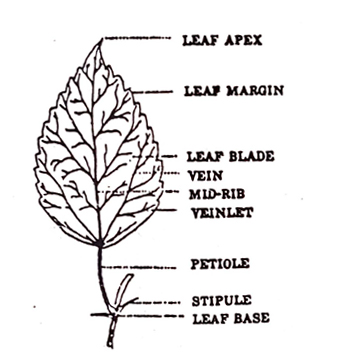
Fig. 1 7: Parts of a leaf (Reproduced from Dutta)
Shape of the leaf
The shape of the leaf-lamina varies from plant and often provides useful diagnostic character for the identification of different leaf drugs.
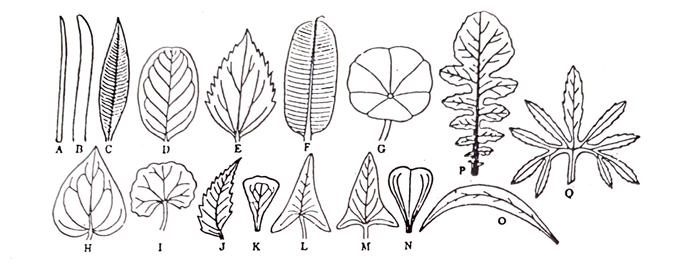
Fig. 18: Shape of the leaf. A, acicular; B, linear; C. lanceolate; D, elliptical or oval, E, ovate; F, oblong; G, rotund or orbicular; H, cordate; I, reniform; J, oblique; K, spathulate. L, sagitate, M, hastate; N, cunneate; 0, falcate; P, lyrate, and Q, pedate. (Reconstructed from Dutta).
The various shapes that are seen in leaves may be described in the following way: A. Acicular, when the leaf is long, narrow and cylindrical, i.e., needle-shaped, as in Pine and Onion; B. Linear, when the leaf is long, narrow and flat, as in grasses; C. Lanceolate, when the leaf is broader in the middle and gradually tapers towards the-two ends, as in Nerium and Polyalthia; D. Elliptical, when a leaf assumes the shape of an ellipse. In this case, the leaf is long and . is almost equally expanded all through its length, as in Guava and Vinca; E. Ovate, when a leaf assumes the shape of a longitudinally halved egg, i.e. broader at the base and gradually tapering towards the apex, as in China rose and Stramonium. When the shape is inversely ovate, it is said to be Obovate, as in Terminalia; F. Oblong, when the leaf is long and equally broad all through its length, as in Banana; G. Rotund or orbicular, when the blade is circular in outline with the petiole arising from the center, as in Water Lily; H. Cordate, when the leaf acquires the shape of the heart, as in Piper betle. When it is inversely heart-shaped, the shape is called Obcordate, as in Oxalis; I. Reniform, a kidney-shaped leaf, as in Hydrocotyle; J. Oblique, when the two halves of the blade are unequal and the leaf assumes a narrowly ovate shape, as in Neem; K. Spathulate, when the shape is like that of a spatula or spoon, as in Calendula; L. sagitate, when the leaf is arrow-shaped as in Sagittaria and Coco-yam; M Hastate, when the two lobes of a sagitate leaf are directed outwards, as in Ipomoea; N. Cunneate, when the leaf is wedge-shaped as found in Water lettuce (Pistia); O. Falcate, a sickle-shaped leaf, as in Eucalyptus; P. Lyrate, when the shape is like that of a lyre, i.e., with a large terminal lobe and some smaller lateral lobes, as in Mustard and Radish; Q. Pedate, when the leaf looks like the claw of a bird, with the lobes spreading outwards, as in Vitis pedata.
Margin of the leaf
The margin of a leaf is often characteristic and provides important diagnostic character for the identification of a leaf drug. The margin may be· A. Entire (smooth even edges); B. Serrate (toothed edges, teeth pointing towards the apex of the leaf); C. Dentate (toothed edges, teeth pointing outwards); D. Crenate (toothed edges with broad and rounded teeth); E. Repand (wavy or undulated); F. Sinuate (edges turning in and out strongly) and G. Incised edges cut in to sharp, (deep, irregular and unequal teeth). In addition to these types, the leaf margin may vary greatly under various conditions of growth.
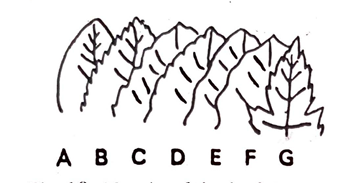
Fig. 19: Margin of the leaf. A, entire B, serrate; C, dentate; D, crenate; E, repand; F, sinuate; G, incised.
Apex of the leaf
The tips or apices of different leaves vary greatly from plant to plant.
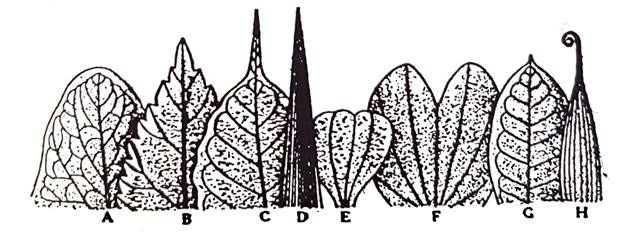
Fig. 20: Apex of the leaf, A, obtuse; B, acute; C, acuminate; D, cuspidate; E, retuse; F, emarginate; G, mucronate, P, cirrhose. (Adopted from Dutta)
They may be described as
A. Obtuse (almost rounded tip); B. Acute (tip tapering to a sharp point) C. Acuminate (tip prolonged into a narrow point); D. Cuspidate (tip with a hard, spiny point); E. Retuse (tip slightly indented); F. Emarginate (tip deeply indented or notched); G. Mucronate (abruptly tipped with a short point), and H. Cirrhose (tip ending in a tendril or in a slender, curled appendage).
Surface of the leaf
Surfaces of a leaf may be smooth or may have some epidermal outgrowths. The leaf is said to be (a) glabrous, when it is covered, sparsely or densely, with hairs. A hairy surface may be (i) pubescent, i. e., covered with short, soft straight hairs; (ii) tomentose, i.e., densely covered with shorts, soft hairs; (iii) hispid i. e., best with rigid or bristly hairs, and (iv) hirsute, i. e., covered with long, coarse stiff hairs.
Texture of the leaf
Texture or feel of the leaf to the touch varies from leaf to leaf and is sometimes very important. in its identification. The texture may be described . as (a) Coriaceous (tough and scabrous); (b) Papery (thin and pliable): (c) Leathery (tough, thick, leather-like), and (d) Succulent (thick, soft and juicy). Other comparative terms are also used to describe the texture of a leaf.
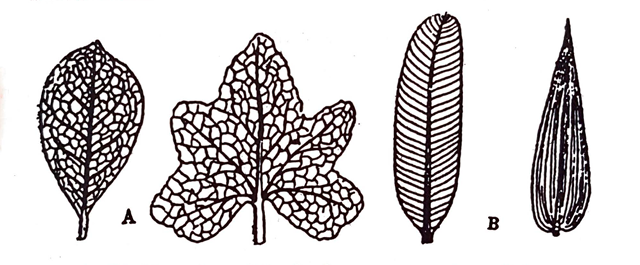
Fig. 21: Venation of the leaf: A, reticulate, B, parallel. (Reconstructed from Bhuya & Timm).
Venation of the leaf
The arrangement of the veins and veinlets and their mode of distribution in the leaf blade is called the venation. Venation is characteristic of the type of a leaf (Fig. 21). When the veins and veinlets, originating from the midrib or its base, repeatedly branch to produce an irregular complex network, it is called a reticulate venation, which is characteristic of the dicot leaves. But when the principal veins run parallel to each other and the veinlets connecting them run transversely, it is called a parallel venation, which is characteristic of the monocot leaves.
Types of leaf
According to the composition of the leaf blade, which may be composed of either a single piece or several separated segments or leaflets, leaves are of two types
- Simple leaves
- Compound leaves
A simple leaf consists of a single blade with entire or incised margin, e.g., Belladonna, Stramonium and Castor leaves.
A leaf is said to be compound when it is composed of a number of separate parts of leaflets, which remain attached to a common axis or rachis. Leaflets of a compound leaf resemble the small simple leaves in structure. Leaves of Cassia species (e.g., Senna) and Tamarindus species are typical examples of this type of leaves. Both these types of leaves constitute many important crude drugs of pharmaceutical importance.
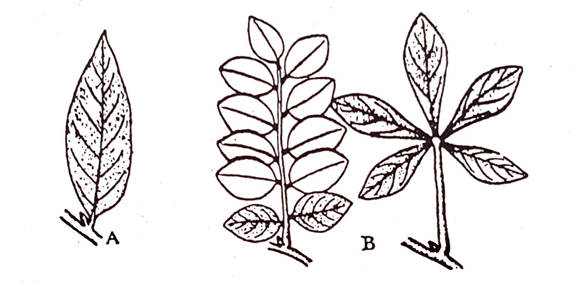
Fig. 22: Types of leaves. A, simple; B, Compound. (Reconstructed from Dutta).

